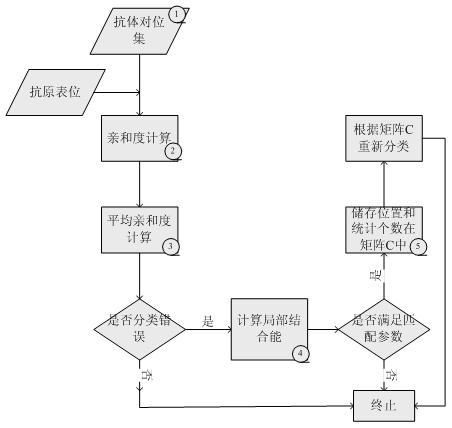Mode identification method based on artificial immune antigen-antibody binding energy
A pattern recognition and artificial immune technology, applied in the field of recognition, can solve problems such as the accuracy rate needs to be improved, the intelligent algorithm is complex, etc.
- Summary
- Abstract
- Description
- Claims
- Application Information
AI Technical Summary
Problems solved by technology
Method used
Image
Examples
Embodiment 1
[0046] seefigure 1 , the pattern recognition method based on the binding energy of artificial immune antigen-antibody is characterized in that: firstly, the overall recognition is carried out, and the affinity between the antigen epitope and the antibody paraposition is calculated by using the Euclidean distance, and the initial pattern recognition is completed; then, The secondary pattern recognition is performed by judging whether the local binding energy of the corresponding position between the antigen epitope and the antibody parasite satisfies the matching parameters. The optimal value range of the matching parameters is obtained according to various international standard classification data tests.
Embodiment 2
[0048] This embodiment is basically the same as Embodiment 1, and the special features are as follows:
[0049] The affinity calculation method between the antigen epitope and the antibody paraposition is:
[0050] The training sample given by the user is used as the antibody alignment, using n Dimensional real number vector representation, the first i Category k antibodies can show
[0051] Shown as:
[0052] (1)
[0053] in , Antibody paratope middle n a local binding site, for n set of real numbers.
[0054] No. j epitope It can be expressed as:
[0055] (2)
[0056] in , epitope of n a local binding site. During recognition, the antibody against epitope The local binding sites at the corresponding positions in the protein bind to each other.
[0057] The affinity between the antigen epitope and the antibody parasite is obtained by calculating the Euclidean distance between the two, and the specific calculation formula is as follows:...
Embodiment 3
[0067] This embodiment is basically the same as Embodiment 2, combined with specific implementation, the special features are as follows:
[0068] Using the international standard classification data Iris as a specific example, Iris data is 4-dimensional data, a total of three categories, each category has 50 samples, a total of 150 samples, the first 10 samples of each category are selected as training samples (antibody Counterpoint), and the remaining 40 are used as test samples (antigenic epitopes) for testing the performance of the algorithm. The specific steps of the algorithm are as follows:
[0069] Use formula (1) and formula (2) to calculate the average affinity between each antigenic epitope and each antibody parasite of each class, and perform initial pattern recognition on the antigenic epitope according to the affinity. At this point, most of the antigenic epitopes can be classified into the correct category, and the misclassified antigenic epitopes are shown in ...
PUM
 Login to View More
Login to View More Abstract
Description
Claims
Application Information
 Login to View More
Login to View More - Generate Ideas
- Intellectual Property
- Life Sciences
- Materials
- Tech Scout
- Unparalleled Data Quality
- Higher Quality Content
- 60% Fewer Hallucinations
Browse by: Latest US Patents, China's latest patents, Technical Efficacy Thesaurus, Application Domain, Technology Topic, Popular Technical Reports.
© 2025 PatSnap. All rights reserved.Legal|Privacy policy|Modern Slavery Act Transparency Statement|Sitemap|About US| Contact US: help@patsnap.com



